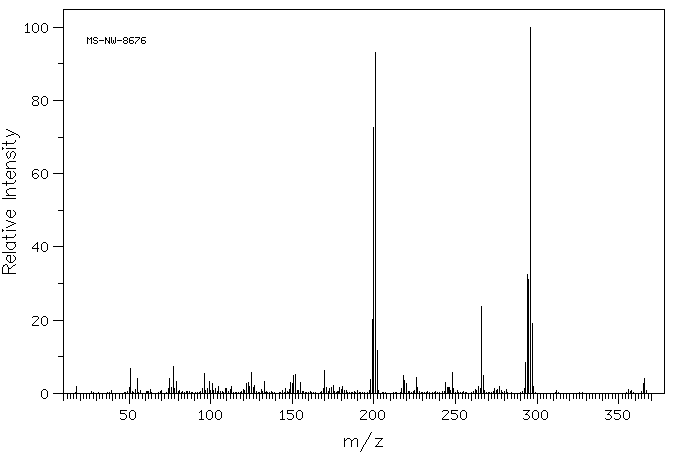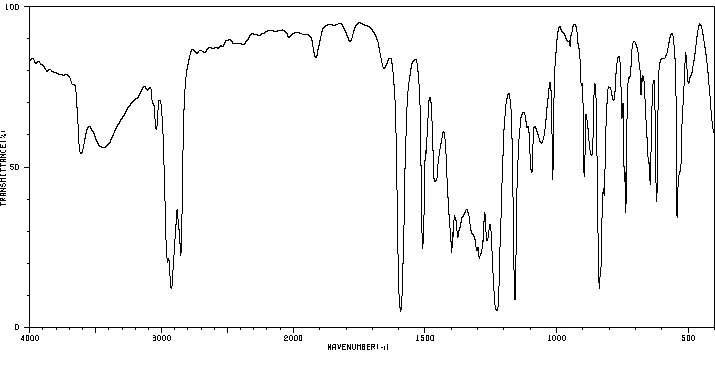tris(4-fluorophenyl)borane | 47196-74-7
中文名称
——
中文别名
——
英文名称
tris(4-fluorophenyl)borane
英文别名
Tris(p-fluorophenyl)borane
CAS
47196-74-7
化学式
C18H12BF3
mdl
——
分子量
296.099
InChiKey
YPVVTWIAXFPZLS-UHFFFAOYSA-N
BEILSTEIN
——
EINECS
——
-
物化性质
-
计算性质
-
ADMET
-
安全信息
-
SDS
-
制备方法与用途
-
上下游信息
-
文献信息
-
表征谱图
-
同类化合物
-
相关功能分类
-
相关结构分类
计算性质
-
辛醇/水分配系数(LogP):2.62
-
重原子数:22
-
可旋转键数:3
-
环数:3.0
-
sp3杂化的碳原子比例:0.0
-
拓扑面积:0
-
氢给体数:0
-
氢受体数:3
SDS
反应信息
-
作为反应物:描述:参考文献:名称:路易斯酸性硼烷、路易斯碱和平衡常数:定量路易斯酸度/碱度标度的可靠支架摘要:基于三芳基硼烷与各种以 O、N、S 和 P 为中心的路易斯碱在二氯甲烷中反应的 90 个实验平衡常数,开发了针对以硼为中心的路易斯酸的定量路易斯酸度/碱度标度。 20℃。使用线性自由能关系 log K B = LA B + LB B进行分析,可以通过两个描述符(一个用于路易斯酸度 ( LA B ))的总和来计算任何类型的硼烷/路易斯碱组合的平衡常数K B。一个用于路易斯碱度(LB B)。所得的路易斯酸度/碱度标度与固定的参考酸/碱无关,并且对于各种类型的三价硼中心路易斯酸有效。事实证明,新开发的路易斯酸度/碱度标度可以通过与量子化学计算或常见的物理有机描述符和已知热力学数据(Δ H )的线性关系轻松扩展。此外,该实验平台可用于硼烷催化反应的合理发展。DOI:10.1002/chem.202003916
-
作为产物:描述:参考文献:名称:反式-1-磺酰基氨基-2-异冰片磺酰基氨基环己烷衍生物:出色的手性配体,可将有机锌试剂催化对映选择性地加成酮。摘要:通过使用四异丙氧基钛和衍生自取代的反式-1-磺酰基氨基-2-异冰片醇磺酰基氨基环己烷,生成相应的叔醇,对映体过量(ee)最高> 99%。描述了一种简单有效的合成这些反应中使用的手性配体的方法。DOI:10.1002/chem.200501397
文献信息
-
Benzodipyrrole-based Donor-Acceptor-type Boron Complexes as Tunable Near-infrared-Absorbing Materials作者:Tomoya Nakamura、Shunsuke Furukawa、Eiichi NakamuraDOI:10.1002/asia.201600673日期:2016.7.20Benzodipyrrole‐based donor–acceptor boron complexes were designed and synthesized as near‐infrared‐absorbing materials. The electron‐rich organic framework combined with the Lewis acidic boron co‐ordination enabled us to tune the LUMO energy level and the HOMO–LUMO gap (i.e.,the absorption wavelength) by changing the organic acceptor units, the number of boron atoms, and the substituents on the boron atoms
-
Metal‐Free Tandem Rearrangement/Lactonization: Access to 3,3‐Disubstituted Benzofuran‐2‐(3 <i>H</i> )‐ones作者:Micol Santi、Darren M. C. Ould、Jan Wenz、Yashar Soltani、Rebecca L. Melen、Thomas WirthDOI:10.1002/anie.201902985日期:2019.6.3A novel metal‐free synthesis of 3,3‐disubstituted benzofuran‐2‐(3H)‐ones through reacting α‐aryl‐α‐diazoacetates with triarylboranes is presented. Initially, triarylboranes were successfully investigated in α‐arylations of α‐diazoacetates, however in the presence of a heteroatom in the ortho position, the boron enolate intermediate undergoes an intramolecular rearrangement to form a quaternary center
-
The effect of fluorination on the luminescent behaviour of 8-hydroxyquinoline boron compounds作者:Sondra L. Hellstrom、Juri Ugolotti、George J. P. Britovsek、Tim S. Jones、Andrew J. P. WhiteDOI:10.1039/b712837a日期:——different boron compounds interacting with the hole transporting layer. In layered devices, the boron compounds 1–3 are inferior in their EL performance compared to aluminium tris(8-quinolinoate) (AlQ3). However, when the boron compounds 1, 2 or 3 are doped into a 4,4′-bis(carbazol-9-yl)diphenyl (CBP) host, emission solely attributable to 1–3 is observed. In such devices, the boron compounds 1 and 2一系列不同程度的喹啉硼化合物 氟化作用制备了Ph 2 BQ 1,(4-FC 6 H 4)2 BQ 2和(C 6 F 5)2 BQ 3(其中Q为8-喹啉酸酯)},并在电子显微镜下研究了它们的电子和发光行为。各种有机发光器件结构。循环伏安法 研究表明,随着电离度的增加,电离电势降低。 氟化作用。电致发光(EL)测量显示出越来越多的红移激基复合物发射,其源于与空穴传输层相互作用的不同硼化合物。在分层器件中,硼化合物1-3的EL性能低于铝三(8-喹啉酸酯)(AlQ 3)。但是,当将硼化合物1、2或3掺杂到4,4'-双(咔唑-9-基)二苯基(CBP)主体中时,观察到仅属于1-3的发射。在此类设备中,硼化合物1和2在低至中等电流密度下的性能优于AlQ 3作为发射极。
-
A new building block with intramolecular D-A character for conjugated polymers: ladder structure based on B←N unit作者:Xingxin Shao、Chuandong Dou、Jun Liu、Lixiang WangDOI:10.1007/s11426-019-9518-7日期:2019.10D-A type conjugated polymers is alternating copolymerization of electron-donating (D) monomer and electron-accepting (A) monomer. In this article, we report a new strategy to develop D-A type conjugated polymers, i.e. first fuse the D and A units into a polycyclic structure to produce a building block and then polymerize the building block with another unit. We develop a new building block with ladder构造DA型共轭聚合物的一般策略是给电子(D)单体和受电子(A)单体交替共聚。在本文中,我们报告了一种开发DA型共轭聚合物的新策略,即首先将D和A单元融合成多环结构以生成结构单元,然后将结构单元与另一个单元聚合。我们开发了一种基于B←N单元,B←N桥联的二吡啶基苯(BNDPB)的梯形结构新砌块。在BNDPB的骨架中,一个二胺取代的亚苯基环(D单元)和两个B←N连接的吡啶基环(A单元)稠合在一起以产生多环结构。由于存在分子内DA特征,因此该结构单元自身表现出1.74eV的窄带隙。基于BNDPB的共轭聚合物显示出独特的电子结构,即局部HOMO和离域LUMO,这在常规DA共轭聚合物中很少观察到。聚合物的带隙小于结构单元BNDPB的带隙,并显示近红外(NIR)光吸收(λabs = ca。700 nm)。因此,这项研究不仅提供了设计DA共轭聚合物的新策略,而且提供了一种新型的具有窄带隙的结构单元。
-
Defluorinative Functionalization of Pd(II) Fluoroalkyl Complexes作者:Michael M. Wade Wolfe、James P. Shanahan、Jeff W. Kampf、Nathaniel K. SzymczakDOI:10.1021/jacs.0c09505日期:2020.10.28When subjected to arylboranes, anionic trifluoromethyl and difluorobenzyl palladium(II) complexes undergo fluoride abstraction followed by 1,1-migratory insertion. The resulting intermediate fluoroalkyl species can be induced to undergo a subsequent transmetalation and reductive elimination from either an in situ formed fluoroboronate (FB(Ar3)-) or an exogenous boronic acid/ester (ArB(OR)2) and nucleophilic
表征谱图
-
氢谱1HNMR
-
质谱MS
-
碳谱13CNMR
-
红外IR
-
拉曼Raman
-
峰位数据
-
峰位匹配
-
表征信息
同类化合物
(βS)-β-氨基-4-(4-羟基苯氧基)-3,5-二碘苯甲丙醇
(S,S)-邻甲苯基-DIPAMP
(S)-(-)-7'-〔4(S)-(苄基)恶唑-2-基]-7-二(3,5-二-叔丁基苯基)膦基-2,2',3,3'-四氢-1,1-螺二氢茚
(S)-盐酸沙丁胺醇
(S)-3-(叔丁基)-4-(2,6-二甲氧基苯基)-2,3-二氢苯并[d][1,3]氧磷杂环戊二烯
(S)-2,2'-双[双(3,5-三氟甲基苯基)膦基]-4,4',6,6'-四甲氧基联苯
(S)-1-[3,5-双(三氟甲基)苯基]-3-[1-(二甲基氨基)-3-甲基丁烷-2-基]硫脲
(R)富马酸托特罗定
(R)-(-)-盐酸尼古地平
(R)-(-)-4,12-双(二苯基膦基)[2.2]对环芳烷(1,5环辛二烯)铑(I)四氟硼酸盐
(R)-(+)-7-双(3,5-二叔丁基苯基)膦基7''-[((6-甲基吡啶-2-基甲基)氨基]-2,2'',3,3''-四氢-1,1''-螺双茚满
(R)-(+)-7-双(3,5-二叔丁基苯基)膦基7''-[(4-叔丁基吡啶-2-基甲基)氨基]-2,2'',3,3''-四氢-1,1''-螺双茚满
(R)-(+)-7-双(3,5-二叔丁基苯基)膦基7''-[(3-甲基吡啶-2-基甲基)氨基]-2,2'',3,3''-四氢-1,1''-螺双茚满
(R)-(+)-4,7-双(3,5-二-叔丁基苯基)膦基-7“-[(吡啶-2-基甲基)氨基]-2,2”,3,3'-四氢1,1'-螺二茚满
(R)-3-(叔丁基)-4-(2,6-二苯氧基苯基)-2,3-二氢苯并[d][1,3]氧杂磷杂环戊烯
(R)-2-[((二苯基膦基)甲基]吡咯烷
(R)-1-[3,5-双(三氟甲基)苯基]-3-[1-(二甲基氨基)-3-甲基丁烷-2-基]硫脲
(N-(4-甲氧基苯基)-N-甲基-3-(1-哌啶基)丙-2-烯酰胺)
(5-溴-2-羟基苯基)-4-氯苯甲酮
(5-溴-2-氯苯基)(4-羟基苯基)甲酮
(5-氧代-3-苯基-2,5-二氢-1,2,3,4-oxatriazol-3-鎓)
(4S,5R)-4-甲基-5-苯基-1,2,3-氧代噻唑烷-2,2-二氧化物-3-羧酸叔丁酯
(4S,4''S)-2,2''-亚环戊基双[4,5-二氢-4-(苯甲基)恶唑]
(4-溴苯基)-[2-氟-4-[6-[甲基(丙-2-烯基)氨基]己氧基]苯基]甲酮
(4-丁氧基苯甲基)三苯基溴化磷
(3aR,8aR)-(-)-4,4,8,8-四(3,5-二甲基苯基)四氢-2,2-二甲基-6-苯基-1,3-二氧戊环[4,5-e]二恶唑磷
(3aR,6aS)-5-氧代六氢环戊基[c]吡咯-2(1H)-羧酸酯
(2Z)-3-[[(4-氯苯基)氨基]-2-氰基丙烯酸乙酯
(2S,3S,5S)-5-(叔丁氧基甲酰氨基)-2-(N-5-噻唑基-甲氧羰基)氨基-1,6-二苯基-3-羟基己烷
(2S,2''S,3S,3''S)-3,3''-二叔丁基-4,4''-双(2,6-二甲氧基苯基)-2,2'',3,3''-四氢-2,2''-联苯并[d][1,3]氧杂磷杂戊环
(2S)-(-)-2-{[[[[3,5-双(氟代甲基)苯基]氨基]硫代甲基]氨基}-N-(二苯基甲基)-N,3,3-三甲基丁酰胺
(2S)-2-[[[[[((1S,2S)-2-氨基环己基]氨基]硫代甲基]氨基]-N-(二苯甲基)-N,3,3-三甲基丁酰胺
(2S)-2-[[[[[[((1R,2R)-2-氨基环己基]氨基]硫代甲基]氨基]-N-(二苯甲基)-N,3,3-三甲基丁酰胺
(2-硝基苯基)磷酸三酰胺
(2,6-二氯苯基)乙酰氯
(2,3-二甲氧基-5-甲基苯基)硼酸
(1S,2S,3S,5S)-5-叠氮基-3-(苯基甲氧基)-2-[(苯基甲氧基)甲基]环戊醇
(1S,2S,3R,5R)-2-(苄氧基)甲基-6-氧杂双环[3.1.0]己-3-醇
(1-(4-氟苯基)环丙基)甲胺盐酸盐
(1-(3-溴苯基)环丁基)甲胺盐酸盐
(1-(2-氯苯基)环丁基)甲胺盐酸盐
(1-(2-氟苯基)环丙基)甲胺盐酸盐
(1-(2,6-二氟苯基)环丙基)甲胺盐酸盐
(-)-去甲基西布曲明
龙蒿油
龙胆酸钠
龙胆酸叔丁酯
龙胆酸
龙胆紫-d6
龙胆紫









